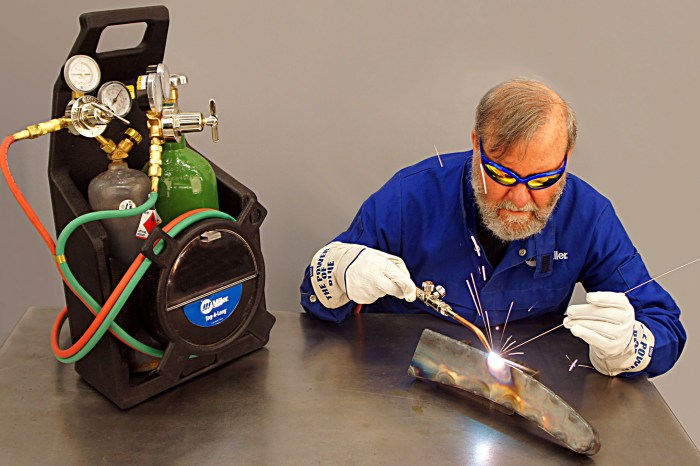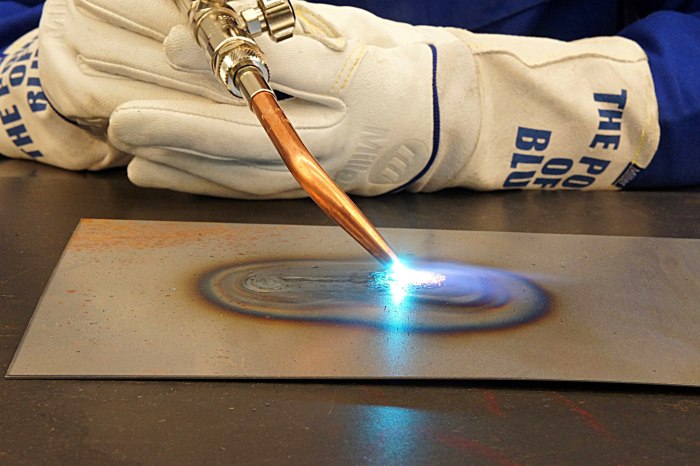Weld aluminum with oxy acetylene – Welding aluminum with oxy acetylene is a specialized technique that requires precision, skill, and a thorough understanding of the process. This comprehensive guide will delve into the intricacies of oxy acetylene welding, empowering you with the knowledge and techniques to achieve exceptional results in your aluminum welding endeavors.
From essential safety precautions to advanced welding techniques, this guide will provide a comprehensive overview of the subject matter, ensuring that you have the necessary foundation to excel in this demanding craft.
Safety Precautions
Welding aluminum with oxy-acetylene requires strict adherence to safety protocols to prevent accidents and health hazards. It is crucial to wear proper protective gear, including a welding helmet, gloves, and fire-resistant clothing, to shield the body from intense heat, sparks, and molten metal.
Proper ventilation is paramount to remove toxic fumes and gases released during welding. These fumes can cause respiratory problems if inhaled. Welding should be performed in a well-ventilated area or with adequate exhaust systems.
The oxy-acetylene welding process poses specific hazards, such as the risk of explosions and fires. It is essential to ensure that all equipment is in good condition, hoses are secure, and the work area is clear of flammable materials.
Equipment Setup

An oxy-acetylene welding system comprises several components: an oxygen tank, an acetylene tank, regulators to control gas flow, hoses, a welding torch, and welding tips. Setting up the equipment involves connecting the tanks to the regulators, attaching the hoses to the regulators and torch, and adjusting the gas flow rates.
The correct welding tips and torch are crucial for successful welding. Different tip sizes are available for various welding thicknesses, and the torch should be chosen based on the desired heat output.
Welding Techniques

Welding aluminum with oxy-acetylene involves specific techniques to achieve strong and durable joints. The joint must be prepared by cleaning and removing any impurities or oxides. A flux is applied to the joint to prevent oxidation during welding.
The welding process begins by igniting the torch and adjusting the flame to a neutral setting. The torch is held at a slight angle to the joint, and the molten aluminum is deposited into the joint while the edges of the metal are fused together.
Different welding rods and fluxes are available, each with specific properties and applications. Selecting the appropriate materials is crucial for achieving optimal results.
Joint Design
The type of joint used in aluminum welding depends on the application and the desired strength and durability. Common joint designs include butt joints, edge joints, and T-joints.
Butt joints are suitable for joining two pieces of metal edge-to-edge, while edge joints are used to join two pieces of metal at a 90-degree angle. T-joints are used to join a perpendicular piece of metal to a flat surface.
Each joint design has its advantages and disadvantages, and the choice depends on the specific requirements of the application.
Troubleshooting Common Problems: Weld Aluminum With Oxy Acetylene

Various problems can arise when welding aluminum with oxy-acetylene. Porosity, caused by trapped gases, is a common issue. It can be prevented by using a clean flux and ensuring proper joint preparation.
Cracking can occur due to excessive heat or improper joint design. It is essential to adjust the flame temperature and select the appropriate joint design to avoid this problem.
Regular maintenance and calibration of equipment are crucial to prevent malfunctions and ensure optimal welding performance.
Applications
Oxy-acetylene welding is widely used in various applications where aluminum welding is required. It is commonly employed in the automotive, aerospace, and construction industries.
Advantages of using oxy-acetylene welding for aluminum include its portability, affordability, and the ability to produce high-quality welds. It is also suitable for welding thin and delicate aluminum components.
Compared to other aluminum welding methods, oxy-acetylene welding offers a cost-effective solution for small-scale projects and repairs.
FAQ Compilation
What are the key safety precautions to observe when welding aluminum with oxy acetylene?
Proper protective gear, including a welding helmet, gloves, and fire-resistant clothing, is essential. Adequate ventilation is crucial to prevent the inhalation of harmful fumes. Additionally, it is important to be aware of the potential hazards of aluminum dust and molten metal.
What are the essential components of an oxy acetylene welding system?
The system typically includes an oxygen tank, an acetylene tank, a regulator, hoses, a torch, and welding tips. Understanding the function and proper handling of each component is essential for safe and effective welding.
What are the different types of welding rods and fluxes used in aluminum welding?
The choice of welding rods and fluxes depends on the specific aluminum alloy being welded. Common welding rods include ER4043, ER5356, and ER5183, while fluxes can be classified as active, neutral, or inactive based on their chemical composition.